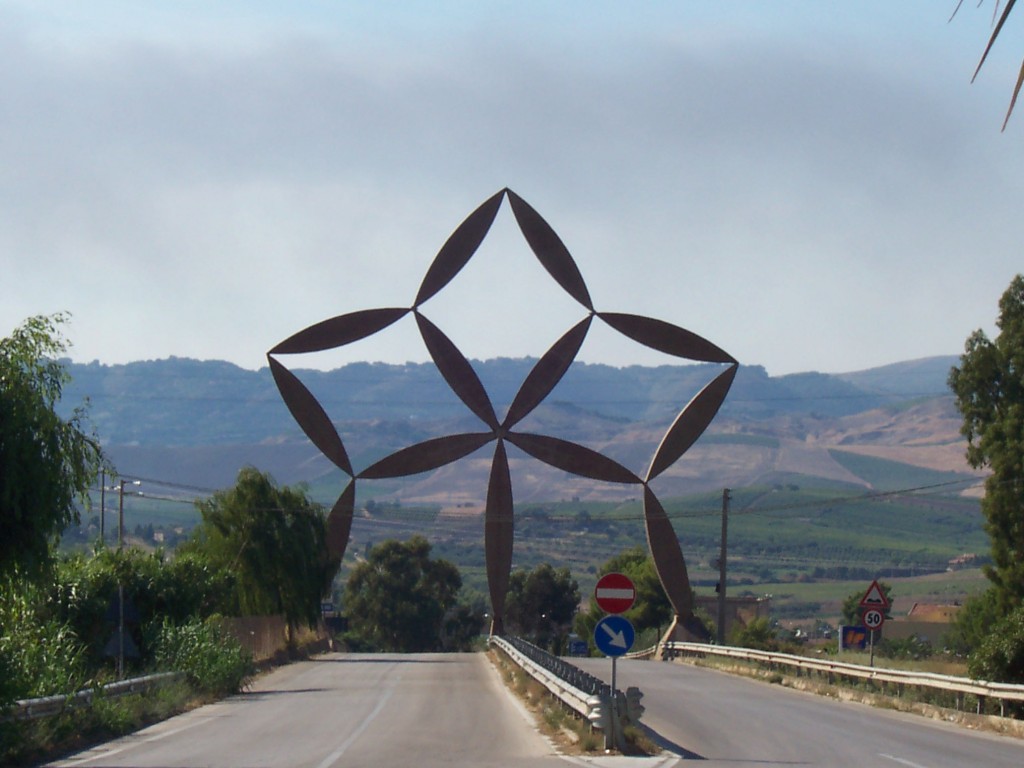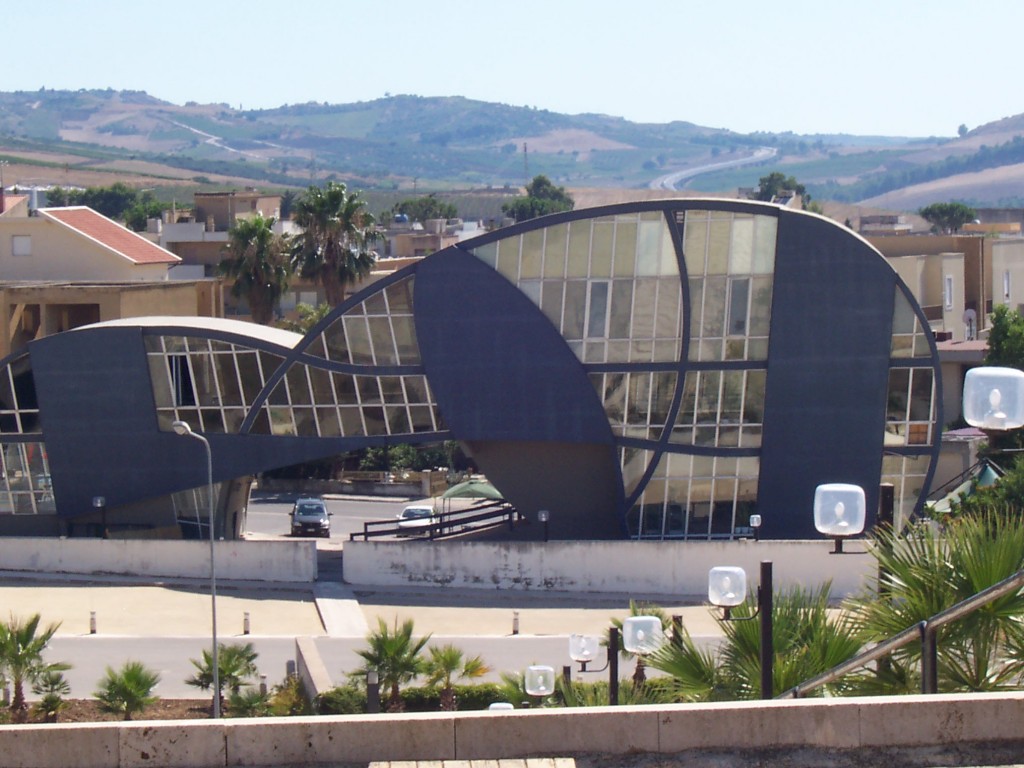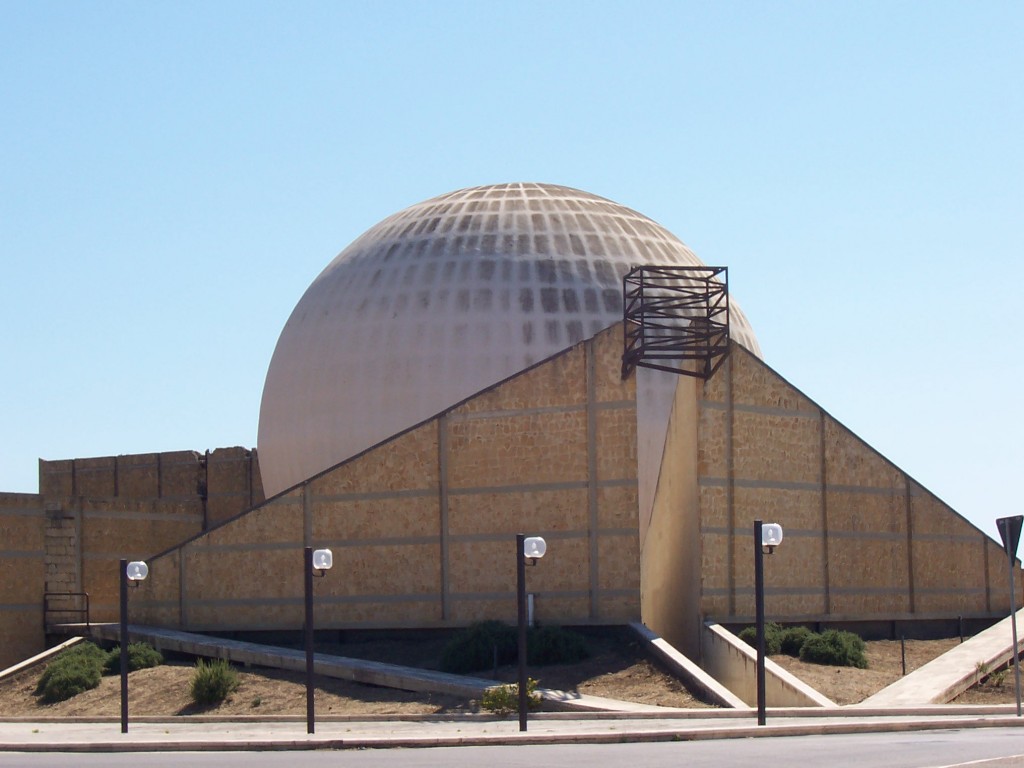CONFRONTARSI, DIALOGARE, SCONTRARSI
Il ruolo della cultura e dell’Arte nella fondazione di una città
Intervista a Enrico Stassi, coordinatore della struttura del Macro
Testo di Sebastian Di Guardo

SDG – Cosa puoi dirci del tuo lavoro a Gibellina?
ES – A Gibellina ero il Direttore del museo di Arte contemporanea, che si trova in un edificio scolastico per metà museo e metà scuola media, la Giovanni XXIII.
SDG – Mi presento meglio e ci presento meglio, l’obiettivo della nostra webzine è trovare un minimo comune denominatore tra persone differenti, lasciando molto spazio al dibattito sull’Arte e l’Architettura. Cerchiamo concretamente di creare una rete comune di persone.
ES – Allora prendo la palla al balzo e ti dico che questa esperienza sarebbe piaciuta molto al sindaco Corrao, il rifondatore di Gibellina, perchè la sua forza – con luci e ombre – è stata quella di essere un medium capace di connettere artisti e intellettuali contagiandoli con uno spirito di collaborazione.
SDG – Un lavoro così incredibile, che io stesso e molti altri abbiamo voluto andare di persona a Gibellina come per “sincerarci” che non fosse un miraggio. Un viaggio particolare, in treno.
ES – Allora siete scesi a Salemi, perchè Gibellina rinacque in contrada Salinella, abbandonando i ruderi del vecchio paese devastato dal terremoto del ‘68.

SDG – Eri li quando è avvenuta la ricostruzione?
ES – Io ho cominciato a lavorare come caposettore musei nel 1984. Però certe cose sono scritte, e per una strana coincidenza nel 1982 andai a Gibellina a fare animazione teatrale per i bambini. Era un periodo in cui c’era un primo nucleo costruito ma gran parte della popolazione viveva ancora nelle baracche a Rampinzeri, e in una baracca eravamo alloggiati anche noi. Gibellina era una landa desolata immersa nel verde, ma di fatto non aveva verde organizzato; allora fummo chiamati a fare un lavoro di sensibilizzazione dei bambini al verde; proprio nell’edificio della scuola elementare, in quei giorni, vi fu un convegno molto importante tra architetti.
SDG – Lei ha visto realizzato il sogno mio e di molti miei colleghi, costruire una città nuova. Cosa le é rimasto impresso di questa esperienza?
ES – Devo farti una premessa. Il terremoto del ‘68 fu il primo disastro dal dopoguerra. Le autorità erano impreparate e favorirono l’emigrazione, con passaporti veloci, timbrati su dei banchetti, per emigrare. Nel 1978 Il sindaco Corrao insieme con Treccani, Guttuso, Sciascia e molti altri scrissero un appello per idee e progetti. Fu fatta una veglia immortalata dal quadro di Guttuso “La notte di Gibellina”. Cominciò questa utopia, che doveva da quel momento confrontarsi, dialogare, scontrarsi con la realtà. La ricostruzione era gestita infatti dal Ministero dei lavori pubblici tramite l’istituto ISES. Prima si pensò ad una conurbazione di paesi ma i progetti venivano rifiutati e il tempo passava, finchè non arrivò il progetto che fu realizzato, ispirato alle città giardino del Nord della Germania e dalla forma di due ali di farfalla con una spina centrale. La scommessa era “umanizzare”, dare un senso al progetto e alla rinascita. La molla della solidarietà é stato il processo fondativo in sé stesso, l’opportunità di lasciare un segno che abbia una cittadinanza, qualcosa di paragonabile al solco di Romolo.

SDG – A noi sembra davvero interessante inoltre osservare un processo fondativo che si basò molto su un discorso culturale.
ES – Esatto, anzi posso dire che la grande rivoluzione, la grande scommessa di Corrao fu rifondare un luogo sui valori della cultura. Gli contestarono di essere una persona che pecca di hybris, proprio nel senso che ha nel teatro greco, di osare oltre misura. Il museo raccolse commenti molto diversi, contando non solo chi era incuriosito, ma anche chi era spaesato. Alcuni chiedevano cosa c’entrasse tutto questo con Gibellina. Gli stessi abitanti, abituati alla campagna, si ritrovarono con strutture di Staccioli e Colla, non capivano dove mettere gli attrezzi agricoli né perchè le strade erano solo pedonali alternate a strade carrabili. persino i turisti si sentivano traditi, perchè non vedevano né coppole né muli. Per Corrao si trattava di fondare questa città sui valori della cultura in senso ampio. Una cultura contemporanea ma siciliana, caratterizzata dall’arte diffusa, come la tradizione dei pani di san Giuseppe dalle forme barocche come le chiese. Tutto il progetto secondo me rientra in questa follia. Continuando l’esempio, per la festa di S. Giuseppe ogni famiglia organizza un altare con forme di pane, pietanze, frutta; è fondamentale la visita che ogni famiglia fa alle altre. Si tratta di un rito grazie al quale ci si rende conto della situazione della comunità. Un altro esempio: la festa di S. Rocco, con la sfilata del “Presenti”, un lungo drappo broccato decorato, che anticamente era sempre lo stesso, ma poi fu elaborato ogni anno da un artista diverso, come Alighiero Boetti, poi Consagra e altri.
SDG – Stiamo parlando di rigenerazione culturale e diffusione della cultura. Quali sono stati i momenti peggiori di questo processo secondo te?
ES – Ancora una premessa. Questo strano posto, dove per prima cosa vedi la stella di Consagra in acciaio inox, Cappello, le Piazze, il palazzo Venezia, il municipio di Samonà e poi ancora il grande aratro della tragedia di Didone di Pomodoro.. quando vedi tutto ciò è importante capire che questi segni d’Arte non sono stati concepiti come arredo della città. Anzi molte opere arrivarono quando la popolazione non si era trasferita e sono come dei punti di riferimento. Si diceva “staju unni c’è Melotti” (“abito dove c’è Melotti”) quindi non c’era identità e l’artista dialogava, si rapportava o si scontrava con la città dandole senso un pezzo alla volta. I problemi arrivarono quando la partecipazione cominciò a diminuire, come anche i fondi per le Orestiadi (manifestazioni culturali, ndr). Ci si rese conto che era un piccolo comune di 5000 anime e la manutenzione delle opere era un problema serio.
SDG – Basti pensare alla chiesa di Quaroni, il cui tetto crollò e che è stata completata solo nel 2010.
ES – Lo ricordo, nel 1994, stavamo mettendo in scena un testo di Salvo Licata sui fasci siciliani quando si sentì il crollo nella notte. Il 1994 fu l’anno in cui Corrao perse le elezioni, per soli 17 voti; ma aveva smosso davvero l’orgoglio dei cittadini, che andavano a fare le foto del matrimonio con le opere d’arte che preferivano per esempio. Il Cretto di Burri era argomento di scontro di ogni campagna elettorale, tra l’opposizione che lo considerava un’opera criminale e Corrao che lo descriveva come un monumento ad eterna memoria che evita una squallida imbalsamazione del passato. Tutto ciò andava bene, ma la popolazione aveva difficoltà con alcuni problemi pratici, come la nettezza urbana. Oggi si tratta di una realtà di cui tener conto, un patrimonio che non è solo a carico del comune, ma anche della regione, come accade a Segesta con il teatro antico.

SDG – Abbiamo parlato di continuità culturale, ma anche di ibridazione, di innesti, per esempio riguardo la forma della città. Fu una scelta giusta?
ES – L’ibridazione é stata una scelta di necessità. Dopo 13 anni passati a Gibellina, mi sono liberato di molte cose. Spesso si vive di idee, ma a volte esse sono frutto di uniformità, se non di bigottismo…
TO CONFRONT, TO DIALOGUE, TO COLLIDE
The role of culture and art in the foundation of a city.
Interview to Enrico Stassi, MACRO coordinator.
Text by Sebastian Di Guardo, translations by Laura Dumbrava and Orazio Caruso

SDG – What can you tell us about your work at Gibellina?
ES – I was the manager of Gibellina Museum of Contemporary Art located in a scholastic building, half museum and half school, “John XXIII”.
SDG – I present myself and us better, the goal of our webzine is to find a common denominator between different persons by allowing space for debate on Art and Architecture. We concretely try to create a common network of persons.
ES – Then I seize the moment and I tell you that this experience could have been liked by the mayor Corrao, the re-founder of Gibellina, because its strength – with lights and shades – was that to be a medium capable of connecting artists and intellectuals by infecting them with a spirit of collaboration.
SDG – Such an incredible work that I myself and many others would have wanted to go ourselves to Gibellina in order to “be sure” that it wasn’t a mirage. A particular journey,by train.

ES – So you got off at Salemi because Gibellina was reborn in the Salinella district abandoning the ruins of the old country which was devastated by the 68’s earthquake.
SDG – Were you there when the reconstruction took place?
ES – I started to work as head of sector museums in 1984. But certain things are linked to the fate and by strange coincidence in 1982 I went to Gibellina to do theatrical animation for children. It was a time when there was a core group of building but a big part of the population was still living in Rampinzeri’s shacks and we too lived in a shack.
Gibellina was a wasteland surrounded by nature but in fact it had no organized green; then we were called to do a job of making children aware of the green; just in the building of the primary school, in those days, there was a very important meeting between architects.
SDG – You saw my and many of my colleagues’ dream realized, building a new city. In what way did this experience impress you?

ES – I have to make an introduction. The earthquake of ’68 was the first disaster after the war. The authorities were not prepared and they encouraged the emigration with fast passports stamped on the banquets, in order to emigrate. In 1978, Mayor Corrao together with Treccani, Guttuso, Sciascia and many others wrote an appeal for ideas and projects. It was made a vigil immortalized by Guttuso framework of “The Night of Gibellina”. He started this utopia which was designed then to discuss, to dialogue, to collide with reality. The reconstruction was in fact ran by the Ministry of Public Works through the institution ISES. Firstly, they thought of a conurbation of countries, but the projects were rejected and time was passing until the project was built. This was inspired by the garden city of North Germany with its shape of two wings of a butterfly with a central spine. The bet was to “humanize”, to give a meaning to the project and to the recreation. The spring of solidarity was the founding process in itself, an opportunity to leave a mark which has a citizenship, something comparable to the furrow of Romulus.
SDG – To us, it seems very interesting to observe a founding process too which was based on a very cultural discourse.
ES – That’s right, in fact I can say that the great revolution, the big bet of Corrao, was to re-find a place based on the values of culture. They challenged him to be a person who is guilty of hubris, in the sense as in the Greek theater: to dare beyond measure. The museum collected very different comments counting not only those who were intrigued, but also those who were lost. Some of them wondered what all of this had to do with Gibellina. The inhabitants, accustomed to the country, found themselves with structures by Staccioli and Colla and they did not understand where to put the agricultural tools or why the roads were only pedestrian alternating driveways. Even tourists felt betrayed because they did not see either caps or mules. Corrao meant to found this city on the values of the large culture. A contemporary but Sicilian culture characterized by the widespread art as the tradition of St. Joseph’s loaves from the Baroque style of the churches. I think the whole project is part of this madness. Continuing the example, for the feast of St. Joseph each family organizes an altar with loaves of bread, food, fruit; it is critical that each family visits the other. It is a ritual through which we become aware of the situation of the community. Another example: the feast of St. Rocco with a parade of “Presenti”, a long brocade decorated cloth which in ancient times was always the same but then it was done annually by a different artists such as Alighiero Boetti and then Consagra and others.
SDG – We are talking about cultural regeneration and culture spreading. What were the worst moments of this process in your opinion?
ES – Another premise. This strange place where the first thing you see is the star of Consagra stainless steel, Cappello, the Piazzas, the Palazzo Venezia, the town hall and then Samonà still plow the great tragedy of Dido of Pomodoro. When you see all of this, it is important to understand that these signs of Art are not conceived as city furniture. Indeed, many works came when the population had not moved and they are as reference points. He said “staju unni c’è Melotti ” (“I live where Melotti is”) so there was no identity and the artist conversed, he was linked or clashed with the city by giving meaning piece by piece. The problems came when the investment began to decline as well as the funds for Orestiadi (cultural events, etc.). He realized that it was a small town of 5000 people and the maintenance of the works was a serious problem.

SDG – Just think of the Quaroni church whose roof collapsed and was completed only in 2010.
ES – I remember it, back in 1994, we were staging a text of Salvo Licata on Sicily fascism when we heard the crash during the night. 1994 was the year in which Corrao lost the election for only 17 votes; but he had really commoved citizens’ pride that were going to take pictures of the wedding with the works of art that they preferred, for instance. The Burri Cretto was contentious issue of every election campaign including the opposition who considered the work a criminal one while Corrao described it as a monument to eternal memory that avoids a squalid embalming of the past. Everything was fine but the population had difficulty with some practical problems such as garbage. Today it is a reality to be reckoned with, a heritage that is not only the responsibility of the municipality but also of the region as it happens in Segesta with the ancient theater.
SDG – We have talked about cultural continuity but also about hybridization, about grafting, as an example regarding the city shape. Was it a right choice?
ES – The hybridization had been a choice of necessity. After 13 years of Gibellina, I got rid of a lot of things. We often thrive on ideas but sometimes they are the result of uniformity, if not bigotry…
